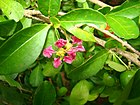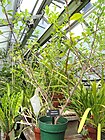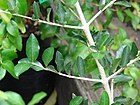Note: This is a project under development. The articles on this wiki are just being initiated and broadly incomplete. You can Help creating new pages.
Difference between revisions of "Malpighia emarginata - Acerola"
(→Parts Used) |
(→Commonly seen growing in areas) |
||
| Line 58: | Line 58: | ||
==Commonly seen growing in areas== | ==Commonly seen growing in areas== | ||
| − | {{Commonly seen| | + | {{Commonly seen|Subtropical areas}}, {{Commonly seen|Meadows}}, {{Commonly seen|Borders of forests and fields}}. |
==Photo Gallery== | ==Photo Gallery== | ||
Revision as of 16:17, 18 October 2018
Malpighia emarginata is a tropical fruit-bearing shrub or small tree in the family Malpighiaceae. Acerola is native to South America, southern Mexico, Puerto Rico, Brazil, and Central America.
Contents
- 1 Uses
- 2 Parts Used
- 3 Chemical Composition
- 4 Common names
- 5 Properties
- 6 Habit
- 7 Identification
- 8 List of Ayurvedic medicine in which the herb is used
- 9 Where to get the saplings
- 10 Mode of Propagation
- 11 How to plant/cultivate
- 12 Commonly seen growing in areas
- 13 Photo Gallery
- 14 References
- 15 External Links
Uses
Scurvy, Diabetes, Cancer Prevention, Anti-Aging action, Immune System, Metabolic disorders, Heart Health, Digestion.
Parts Used
Chemical Composition
Acerola provides a rich source of vitamin C, about 1000 to 4000 mg per 100 grams. The green, unripe fruits contain twice the amount of Vitamin C than the ripe fruits.[1]
Common names
| Language | Common name |
|---|---|
| Kannada | |
| Hindi | |
| Malayalam | |
| Tamil | |
| Telugu | |
| Marathi | NA |
| Gujarathi | NA |
| Punjabi | NA |
| Kashmiri | NA |
| Sanskrit | |
| English | Barbados Cherry |
Properties
Reference: Dravya - Substance, Rasa - Taste, Guna - Qualities, Veerya - Potency, Vipaka - Post-digesion effect, Karma - Pharmacological activity, Prabhava - Therepeutics.
Dravya
Rasa
Guna
Veerya
Vipaka
Karma
Prabhava
Habit
Identification
Leaf
| Kind | Shape | Feature |
|---|---|---|
| Simple | ovate-lanceolate | The leaves are divided into 3-6 toothed leaflets, with smaller leaflets in between |
Flower
| Type | Size | Color and composition | Stamen | More information |
|---|---|---|---|---|
| Unisexual | 2-4cm long | Yellow | 5-10 | The flowers are sessile and borne on the short-peduncled cymes |
Fruit
| Type | Size | Mass | Appearance | Seeds | More information |
|---|---|---|---|---|---|
| simple | 1 to 3 cm | The drupes are in groups of three or pairs | many | {{{6}}} |
Other features
List of Ayurvedic medicine in which the herb is used
- Vishatinduka Taila as root juice extract
Where to get the saplings
Mode of Propagation
How to plant/cultivate
Easily grown in a good soil and a sunny position[3]
Commonly seen growing in areas
Subtropical areas, Meadows, Borders of forests and fields.
Photo Gallery
References
External Links
- Ayurvedic Herbs known to be helpful to treat Scurvy
- Ayurvedic Herbs known to be helpful to treat Diabetes
- Ayurvedic Herbs known to be helpful to treat Cancer Prevention
- Ayurvedic Herbs known to be helpful to treat Anti-Aging action
- Ayurvedic Herbs known to be helpful to treat Immune System
- Ayurvedic Herbs known to be helpful to treat Metabolic disorders
- Ayurvedic Herbs known to be helpful to treat Heart Health
- Ayurvedic Herbs known to be helpful to treat Digestion
- Herbs with Fruits used in medicine
- Herbs with common name in English
- Habit - Herb
- Index of Plants which can be propagated by Seeds
- Index of Plants which can be propagated by Cuttings
- Herbs that are commonly seen in the region of Subtropical areas
- Herbs that are commonly seen in the region of Meadows
- Herbs that are commonly seen in the region of Borders of forests and fields
- Herbs








